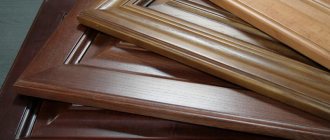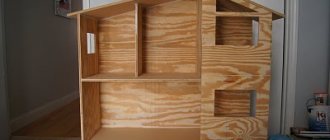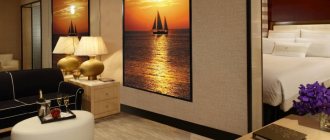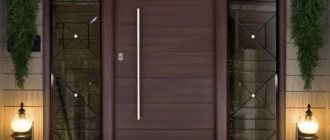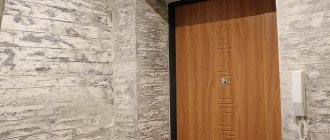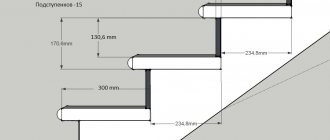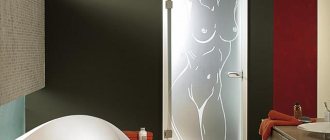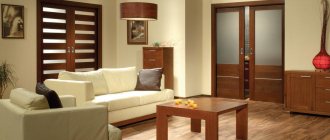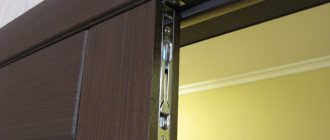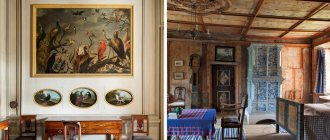Reconstructed veneer
Advances in technology have led to the production of veneers dyed to the full thickness. This made the creation of reconstituted veneer (sometimes called "reclaimed veneer") possible.
To produce reconstituted veneer, wood from fast-growing trees from controlled reforestation areas is used (for example, Italian poplar and Cameroon ayus are used).
Many thin layers of rotary-cut veneer, individually dyed, are glued into a stack using a special technology in such a way that a reconstructed solid is obtained, from which reconstructed veneer is then produced by planing.
| Rice. 8. Reconstructed veneer |
One of the advantages of reconstructed veneer is that it has its own face with a clearly defined structure, pattern and color, most suitable for modern trends and fashion in the production of doors, furniture, and so on.
Fine-line and multi-veneer veneer
Fine-line is a type of reconstructed veneer made from natural wood that imitates certain species.
| Rice. 9. Fine-line veneer |
Features of fine-line veneer sanding
It is recommended to sand fine-line veneer in 2 passes. In the 1st pass, use skins with a grain size of 90-120 (surface leveling), and in the 2nd pass, a grain size of 150-180.
Keep in mind that fine-line veneer is thinner and softer than traditional veneer.
Multi-veneer is a reconstructed veneer made of natural wood, creating the effect of a harmonious combination of given color shades in a simple or complex pattern.
What are the benefits of reconstituted veneer?
The main advantage of reconstructed veneer is its uniformity over a large area (sheets of reconstructed veneer can have dimensions of about 3 m by 1 m), which allows you to bypass the stage of “stitching shirts” from strips, repeatability of decorative and geometric features.
This allows the use of veneer with virtually no waste and significantly reduces the duration of veneering technological stages.
What are the features of painting reconstructed veneer?
Compared to traditional natural veneer, reconstructed veneer is an even more porous and less hard material. The pores in the reconstructed veneer may not be straight, but tortuous, and contain glue, which may require a special technology for filling them.
To increase the uniformity of paint and varnish application on reconstructed veneer, it is sometimes necessary to apply special adhesive primers.
| How to distinguish reconstructed veneer from natural one? The main differences between natural and artificial veneer: The artificial veneer pattern has small structural notches (depicting wood pores), equally located on its surface at an angle of 20 degrees, as they are applied using rollers installed on a rolling machine. Despite the name of artificial veneer, be it rosewood, oak or others, the pattern upon careful examination will be the same everywhere, regardless of color. The pattern of natural veneer is not so repeatable and has pronounced growth rings, depending on the type of wood. The pattern of natural veneer will always be more clearly “alive” than that of artificial veneer, which can be more blurred “dead”. |
Manufacturing methods
The core of the door, or its “body,” can be solid or hollow. A solid door is a solid or spliced solid pine or spruce (or any other coniferous wood). The spliced core of the canvas is made as follows: a frame is created from pine beams, the beams are laid close to each other in it. The resulting structure is sent under the press and fixed with glue. For this purpose, high temperature is rarely used, more often microwaves.
Then the future canvas is ground and calibrated. A plywood sheet or MDF is glued onto it and sent under a cold press to allow the glue to dry. Next, the wooden canvas is sent to the machine and adjusted to the desired size.
On a machine for hollowing out grooves for hinges and fittings (if the fittings are factory-fitted). After this, the door is sent to the next point for sanding, polishing and varnishing. Several such stages go through, after which the door is considered ready and sent to the factory.
A hollow sheet is made as follows: a frame is created from timber and filled with honeycomb filler - cardboard. Another common veneer option is polystyrene foam boards. The future canvas is covered with MDF boards and lined with veneer, often artificial.
Veneered canvases can be subjected to cold or hot pressing, often these two methods are combined. Self-adhesive veneer is a film that is applied to the finished canvas and does not always imitate wood. Often it resembles a marble or stone coating.
What are veneer doors?
A veneer door is a structure made of a frame, filler and veneer. It performs the same role as furniture upholstery. Under such cladding there may be a door leaf made of wood or, a more economical option, made of MDF.
Such products are popular in the construction market. They have good quality characteristics: decorative properties, durability, easy to care for and versatility. Their appearance fits organically into a classic interior, which cannot be said about plastic products. And the price of interior doors made of natural veneer is lower than that of analogues made of solid wood.
Production technology
Veneer doors consist of a frame, filler and facing layer. Two types of construction are popular: from MDF panels (economical option) and solid wood (more expensive option).
Manufacturing technology for veneered MDF doors:
- The frame is assembled from inexpensive wood, for example, pine.
- Fill with filler – corrugated cardboard;
- MDF panels are attached to the door frame;
- A layer of veneer is applied.
- Apply a layer of varnish to protect against moisture.
The process of creating products from solid wood is different in that instead of a frame, a wooden canvas is used - often assembled from small pieces. This reduces the cost.
Veneering - the technology of fixing veneer to a base - comes in two types:
Hot pressing. The veneer sheet is glued with a chemical composition containing formaldehyde at temperatures above 100 °C. This method is widely used due to its low cost.
Cold pressing. More environmentally friendly, but also expensive. They use formaldehyde-free glue, which hardens at a temperature of 30–35 °C.
These methods are used for all types of veneer in the manufacture of interior doors: this is how both natural and multi-veneer are attached.
Advantages and disadvantages
Veneered doors have their advantages and disadvantages. You need to study them before purchasing in order to make the right choice.
Advantages
The veneer covering interior doors has many advantages:
- Attractive appearance and variety of shades. Without a detailed examination, the door appears to be made of natural wood. The veneer retains its color and original pattern of fibers and knots. Unlike laminated flooring, the pattern is unique and natural.
- Affordable cost: by purchasing doors with veneer, you can save money and decorate your home with valuable wood without blowing your budget.
- Health safety, especially for cold pressed doors.
- Durability: service life reaches at least 10 years, and with careful use increases to 15–20 years. Additional coating with paints and varnishes protects the door from moisture and mechanical damage.
- Environmentally friendly. By purchasing a veneer door, a person indirectly participates in environmental protection. The production of the product requires much less wood material than a door made of solid wood. There is practically no visual difference.
All this makes veneered interior doors deservedly in demand.
Flaws
Before purchasing, you need to remember about the disadvantages of the material:
- When gluing to a door leaf using the hot pressing method, formaldehyde is used. In large quantities, vaporized substances can be toxic to humans. Therefore, you need to choose a reliable manufacturer with a good reputation who monitors the safety of their products.
- Veneer is susceptible to sunlight: its color fades in excess light.
- The material does not tolerate contact with moisture and temperature changes. It is used only in internal heated rooms.
Where to buy wood varnish?
The Belinka catalog contains varnish for veneer and other wood coverings. Belinka Yacht is a universal product that is suitable for external and internal work. Boat varnish:
- penetrates well into wood pores,
- protects the material from exposure to ultraviolet radiation, temperature fluctuations and mechanical damage,
- repels water and dirt.
Belinka varnish applies smoothly to wooden furniture and decorative elements. For application you can use a brush or spray gun. For most coatings, two coats are sufficient. At high loads, a three-layer application is required.
Prices for matte wood varnish and other Belinka products are presented in the catalog. To order, add the selected products to your cart and fill out the electronic form. Delivery is made to any city in Russia.
Latest articles
Sealants for wet surfaces
28.08.2020
Paint for solid wood: selection criteria
26.08.2020
Fade-resistant paint: features of choice
24.08.2020
How to make wood shine and increase resistance to wear?
18.08.2020
Paint for door slopes
17.08.2020
How to find out which veneer door is better and of higher quality
There is another way to diversify the collection of apartment doors, but it is used within the “veneered doors” category itself. Classification is carried out according to the type of veneer used. As you know, there are 3 of them:
- Natural (natural);
- Fine-line;
- Eco-veneer
The first is the most expensive because it is made by cutting a thin layer of wood. The same array, but in the form of a film up to 1 mm thick. The second option is also made from wood, but using a different technology. First, the wood sections are glued into one sheet of plywood and then it is cut into thin layers. Eco-veneer is made from pulp industry waste and polypropylene. Door covering materials are listed in descending order of price.
Interior door with ash veneer finish
How can an ordinary person distinguish a door made of natural veneer from eco-veneer and fine line:
- Veneer is an exact imitation of solid wood, with the same beautiful pattern and texture;
- The fine line has many repeating fragments on the surface;
- Eco-veneer is a polymer. Look at the end sections, you can see that this is a film and not a cut of wood. And the second point is that eco-veneer comes in a wide range of colors, including those that are not found in nature.
How to find out which veneer doors are better and of higher quality? Don’t be afraid to touch the canvas, even smell what it smells like. A good door has an absolutely smooth surface and no pungent chemical odors.
Which is better – doors made of solid wood or veneer?
There is an opinion that the choice between doors made of veneer and solid wood is made solely because of the price. The statement is true, but partly, and does not work in all cases. For example, models made from inexpensive solid pine may cost the same or less than beautiful paneled doors made from natural oak veneer.
Interior doors with oak veneer finish
What is better – solid wood or veneer? We suggest making a comparison based on key parameters:
- Scope of application: solid wood doors are installed in richly decorated living rooms, halls, as well as in houses and offices with luxury finishing. Veneered models are less picky about their surroundings, although in order to install a door in the middle and mid-price segment in a room, you need to comply. They are also ordered for apartments, offices, country houses, but they are not necessarily fit into exquisite interiors and expensive antiques are selected as a background;
- Moisture resistance - it is believed that veneer copes better with high humidity, although this criterion depends not so much on the material itself, but on its protection. Still, if you need a door for the bathroom, it is better to get by with veneer so as not to risk a lot of money;
- Price is the undisputed priority on the side of veneer doors. Solid wood is always more expensive than thin cut wood, although if two models are identical in design, is it worth paying more?
- The ability to eliminate defects on the surface: solid wood doors have more of them, although there are special compounds that can be used to make scratches on the veneer invisible, if not eliminated.
Another advantage of veneer doors is their low weight. Installation of solid wood products is usually carried out on three loops. In the case of veneer, reinforcement is not required.
What is the difference between natural veneer and fine-line veneer?
Today, when buying veneered interior doors, consumers are often interested in what material the top layer of the product is made of: natural or reconstructed veneer (fine-line). Such interest is not dictated by idle curiosity, but by the desire to purchase a truly high-quality product. So what are these materials?
Natural veneer: finishing for aesthetes
Natural veneer is one of the popular finishing materials and is a thin, solid cut of wood (as a rule, oak, beech, maple and other valuable species are used to obtain it), which is used to decorate furniture and doors. Products with such a coating look expensive and easily fit into any interior thanks to the vibrant shades of natural wood and its unique texture. Therefore, there are always many people who want to buy veneered interior doors.
Natural veneer is beautiful, environmentally friendly, easy to restore and allows you to create objects with inlay and complex geometry. In addition, veneered products are cheaper than wooden ones, and look as if they were made from solid wood. Among the minuses, it is worth noting the impossibility of choosing sheets of the same design for a series of objects, since each of them has a unique texture, and the fact that natural veneer is very demanding on the temperature regime and humidity level in the room.
Fine-line: innovative technologies in action!
As for reconstructed (engineered) veneer, which is called fine-line, it is, in fact, a budget analogue of natural veneer, made from soft wood of plants such as African ayus or Italian poplar.
The production technology of fine-line is quite complex: first, chips are removed from the logs (this is done in a circle), then they are painted in a special way and laid in layers, creating a certain pattern (all layers are glued together), and after that the workpiece is dried under pressure in a special oven and cut into sheets using the cross-planing method. Thanks to this technology, it is possible not only to create an inexpensive, but 100% natural finishing material without knots and defects with an imitation of any type of wood, but also to obtain any number of sheets with the same pattern.
The only drawback of engineered veneer is its instability to mechanical loads and damage. But manufacturers have found an opportunity to improve the situation: they coat the fine line with heavy-duty varnish, which makes it suitable for decorating furniture and doors.
Veneered doors: the best choice
"Warehouse Doors 169" offers customers interior doors made of natural veneer and products finished with fine-line veneer. Our specialists will advise you on any issues related to the purchase and installation of such doors, as well as:
- will help you choose the most suitable option;
- will tell you about the features of products with different top layers;
- will offer a choice of several doors finished with natural and engineered veneer at the best prices;
- will accept an order for measurements (the service is provided free of charge);
- will arrange the delivery and installation of veneered doors.
Return to list
Advantages and disadvantages
Raw Sheets
The main advantages of fine line veneer include the absence of various defects on it. Thanks to this, users leave positive reviews, which cannot be said about natural veneer. Many people take this advantage as a disadvantage, because defects of this kind make the material more natural and thereby give it uniqueness and value. But this is a matter of personal taste. For many, the rich color spectrum of this material can play an important role.
Important advantages of this type of veneer include its environmental friendliness.
Even if we take into account that the appearance of fine line is similar to plastic, it has every reason to belong to the class of natural materials of natural origin
Fine line veneer is able to withstand temperature changes. Even under such conditions, its properties and appearance remain unchanged. This raw material is also moisture resistant. This advantage is especially useful in rooms with high humidity, where veneered doors have performed well.
The next group of advantages includes its economical cost and ease of operation. It does not require much varnish during the finishing process. In addition, such veneer is quite plastic.
Other advantages include the following facts:
- Color and pattern are created evenly.
- Using a drawing, you can create an imitation of any type of wood.
- It is possible to create a complex of materials with identical surfaces.
- The resulting sheets are convenient to use in the manufacture of interior doors.
If we talk about the other side of the coin, then the disadvantages can be identified such as low strength. Often, soft tree species, such as poplar, are used as a material for the manufacture of this type of veneer, so you should not expect high wear resistance. Even many layers of varnish cannot eliminate this drawback. Such a coating can, on the contrary, harm the raw materials. Hardened layers of varnish increase the likelihood of cracks.
Use of expensive and high-quality veneer
February 21, 2017
Only about 200 types of wood out of 40,000 species worldwide can be used to produce veneer. Experts say that in order to get high-quality veneer you need to see the tree with X-ray vision! Veneer is a unique material that shows all the beauty of wood and demonstrates all the advantages of wood as a design material. In addition to its noble appearance, the value of the natural material lies in the fact that it is made from very valuable wood. A tree that can cost several thousand dollars can be selected to make veneer. It is important to see which areas of wood should be cut to obtain veneer; it is the specialist who can see the internal values of the wood.
Like many modern materials, veneer is very malleable in processing and has a long service life. Due to this, it is used not only in the production of furniture, but also for cladding doors, wall and other types of panels, floor coverings, in the manufacture of musical instruments, car interiors and various decorative interior elements.
A veneered door is a frame made from cheaper wood, usually coniferous. MDF sheets are installed on the frame, onto which veneer plates are attached. The surface of the veneer is varnished to add shine and to protect it from moisture penetration and drying out. A door made in this way does not differ in appearance from a door made of solid wood. Moreover, it looks like a door made of expensive wood - a noble material - since the structure of the wood is preserved and visible. The production and use of veneer has been known to man since ancient times; the main goal is to save expensive wood species. The veneer used for finishing doors is made from valuable wood species: oak, walnut, cherry, wenge. Most people believe that solid wood furniture is much better than veneered furniture, but this is not always the case. Furniture with veneer is much cheaper than even the most inexpensive solid wood furniture. Since furniture with veneer uses completely different materials, such furniture is much lighter and more comfortable than furniture made of wood.
All music lovers around the world recognize that the use of veneer in musical instruments not only increases the status of the instrument, but also improves the quality of the sound produced.
Scope of application of veneer from basic wood species:
- Pine. Characterized by a light shade. Used in furniture production.
- Beech. From light to dark red. In the production of flooring (parquet), in furniture production.
- Nut. The color is light to gray with dark veins. Used in furniture making and door production. Black walnut is used for musical instruments.
- Maple. White color. To avoid yellowing, the veneer is dried after cutting. Used in construction and finishing works. They make wooden objects.
- Cherry. The veneer has a noble red-orange, red-brown color. Used for cladding luxury furniture.
- Birch. Birch veneer is less valuable than other species, with the exception of Karelian birch - this is a rare and valuable species, it has an excellent texture. It is used for cladding furniture.
- Oak. Noble type of wood. It ranges from light straw to red-black in color.
Oak veneer is actively used for: furniture, parquet and other floor coverings; interior doors; panels for finishing walls, interior arches, overlays; interior stairs and steps, etc.
In addition, many other species with beautiful texture are used - acacia, elm, ash, yew. The scope of application of veneer is quite diverse and is not limited only to the furniture industry. Since it looks very solid and expensive, and also allows for carving of any complexity, it becomes indispensable for inlaying wood into any interior items.
Add a comment Cancel reply
Classification
Depending on the method of obtaining the material, veneer is distinguished:
- peeled;
- planed;
- sawn
Peeled veneer
Produced on special machines using the peeling method. Its thickness is 0.1-10 mm. This is a cheap veneer because it is produced in the most cost-effective way.
Birch veneer
To begin with, prepare the workpiece - the tree trunk is cleared of branches, twigs, etc. Then they place it in the machine. Next, the initial processing of the trunk is performed with a cutter: the bark is removed and the workpiece is leveled along the length. After this, a layer of veneer of the required thickness is removed along the entire length of the trunk at the same time.
The resulting semi-finished product is sorted by quality, appearance, etc. This type of veneer, compared to others, is not beautiful enough. Therefore, so that it can be glued to doors, it is processed, for example, painted or subjected to hot printing.
Sliced veneer
It is obtained by planing bars perpendicular to the wood fibers on veneer planing machines, in contrast to peeled wood, which is obtained by cutting the wood layer from a rotating block.
Production of peeled and sliced veneer
Veneer is made from deciduous and coniferous wood such as birch, maple, pear, elm, oak, linden, mahogany, etc. The thickness of the material obtained in this way is 0.2-0.5 mm.
Beautiful veneer for interior and exterior doors is made from twisted wood. In a twisted tree, the fibers inside the trunk do not run smoothly, but are intertwined, forming patterns in the form of knots, bunches, etc.
When producing veneer from such a blank, a layer is removed simultaneously along, across and at an angle to the fibers. This gives a beautiful pearlescent shine to the material. Karelian birch and sugar maple wood are valuable for such veneer. If you stick such veneer on ordinary wooden doors, they will look much richer and more beautiful.
Sawn veneer
It is made by cutting blanks. A high-quality product with a thickness of 0.1-1mm is obtained. However, this type of production is the most uneconomical, since about 60% of the wooden workpiece goes into sawdust.
Based on the wood texture, veneers are distinguished:
- radial (the pattern of annual layers consists of parallel lines that are located along the entire plane);
- semi-radial (the pattern of annual layers consists of parallel lines that occupy at least ¾ of the plane);
- tangential (annual layers create a pattern of cones, angles or curves);
- tangential-end (annual lines create closed curved lines).
According to the material used for the production of veneer, they are distinguished:
- natural;
- fine line;
- multi-veneer;
- eco-veneer
Natural veneer
Made from natural solid tree trunk. At the same time, the structure of the tree is preserved. The cost of natural material is in the middle price category.
Fine-line veneer
It is also made from inexpensive and fast-growing natural wood, but has a highly porous structure. The appearance resembles plastic. With the help of staining, fine-line veneer can imitate natural veneer made from expensive wood. This material is often used for finishing interior doors. It is made as follows. First, natural veneer is produced. Next, the veneer sheets are dried, sorted and painted in a specific color. After this, the sheets need to be glued together.
Fine-line veneer
As a result, the resulting block of veneer sheets is sent under the press. Very thin sheets of fine-line veneer are cut from the finished dried compressed block and glued to the surface to be decorated. In terms of its composition, it consists of 92-94% natural wood. The rest is glue and dye.
Multispon
Refers to a reconstructed type of veneer, like fine line. Geometric patterns are most often applied to its surface.
Eco-veneer
It is a polymer film with the addition of wood fibers. Its surface imitates the surface of natural wood. It is resistant to abrasion, temperature changes and humidity. Veneered doors using eco-veneer are durable and do not lose their performance characteristics for a long time.
What is veneer
First of all, you need to know that veneer is a natural finishing material obtained from wood by removing a thin layer. Technologically, the process is carried out on special peeling machines and consists of splitting wooden beams. During this process, special attention is paid to preserving the wooden structure of the surface, and a sheet with a pattern taken across the grain is more valuable.
Production and use of veneer
The production and use of veneer has been known to man since ancient times; the main goal is to save expensive types of wood .
Veneer is used in designer finishing of interior doors, furniture, musical instruments, and car interiors. Depending on the purpose, different types of wood are used. The veneer used for finishing doors is made from valuable wood species: oak, walnut, cherry, wenge.
Advantages and disadvantages
If you put fine line on the same board with polyvinyl chloride films or other similar facing materials, then it is significantly superior to these materials. We have already learned what fine-line veneer is, now it remains to consider its pros and cons in order to specifically verify the need for this product.
The advantages include a number of important points.
- Ecologically pure. Due to the fact that more than 92% of the texture is natural wood, the material belongs to the category of environmentally friendly. Moreover, its production does not cause any particular harm to nature, since the material is produced from fast-growing tree species.
- Not bad aesthetic indicators. As mentioned above, the canvases have a surface similar to plastic, since there are no roughnesses or knots on it. After treatment, the surfaces look fashionable and expensive.
- Plastic. Due to their bendable structure and high plasticity parameters, sheets are able to take on different geometric configurations and restore their original size and shape after deformation. Sheets are used for decorating almost any surface (lining doors, columns, table tops, decorative elements).
- Price. Compared to classic natural veneer, the fine line line is relatively inexpensive.
- Stability and operational period. The material is characterized by high resistance to temperature fluctuations. In addition, the finish performs well in areas with high humidity levels.
- Impressive assortment. There is a wide selection of different textures, patterns, and colors on the market. This makes it possible to select sheets with the most optimal design that matches the overall style of the interior.
However, despite the mass of positive qualities, the material also has errors.
- Strength. Due to the fact that most of the structure of the material is soft wood, it cannot be called durable. Therefore, the result is a rather fragile coating that has low resistance to mechanical stress. To somehow correct this, several layers of wear-resistant varnish are applied to the surface of the material.
- Heterogeneity. Even when the canvas is made from the same type of wood, its structure and color may vary. In this regard, when purchasing in bulk, it is advisable to order fine line from one batch.
Recommendations for choosing doors
The technology for the production of entrance groups is based on gluing eco-veneer to the door leaf. The door itself is made of wood or MDF boards. There are regular and sliding models, “accordions” and “coupes”. Such designs are inexpensive. Entrance areas covered with such finishing material can replace expensive products made of natural wood.
The choice of interior doors made from eco-veneer from the manufacturer should be made based on the following rules:
- Determine for yourself what function the future structure should perform. Models with transparent glass inserts should not be installed in a shower, bathroom, or restroom.
- Choose products according to the style features of the room.
- Select the texture, fittings and tone in accordance with the color of the floor, baseboards, and other decorative elements in the room.
Ask the seller for a quality certificate for the product. Ask about the level of environmental friendliness and safety of the model. Inspect the ends of the door leaf - they are never processed. At these joints all layers of the product and finishing will be visible.
Distinctive characteristics
Eco-veneer is an environmentally friendly material with a visually attractive texture. It imitates the texture of natural wood and has positive quality characteristics.
Among them:
- presence of a unique 3D effect;
- wide choice of decor and color palette;
- glossy, matte or silky surface structure;
- long period of use;
- strength - cracks do not appear on the coating, the doors do not change texture for a long period and retain their original appearance;
- environmental friendliness - the products do not pose a threat to humans.
Among other features of door structures, it should be noted that the drawers are made in the form of “sandwiches”. They use timber with a homogeneous structure, which has good resistance to deformation, excellent mechanical properties, excellent fire resistance, and low weight.
Door design
All eco-veneer door models are multi-layered and consist of:
- base made of natural pine or high-strength laminated timber;
- upholstery (MDF panels);
- decorative eco-veneer covering.
Most doors made of eco-veneer are structures with four sides - two vertical and two horizontal. They are connected into a frame into which glass inserts or MDF boards are inserted.
Production technology
Eco-veneer is produced using a unique method. Wood processing waste is used, which is crushed using specialized equipment, turning it into small fibers. The material is painted and thoroughly mixed, followed by gluing into a single thin web. Using this technology, products can be given absolutely any shade, with or without wood imitation.
Sheet material is used to wrap the door leaf on all sides. All parts of the structure are covered with film before assembly. The elements are assembled so that the joints of the material remain inside. The result is a one-piece coating without edges, which significantly increases the model’s resistance to moisture and extends its service life.
